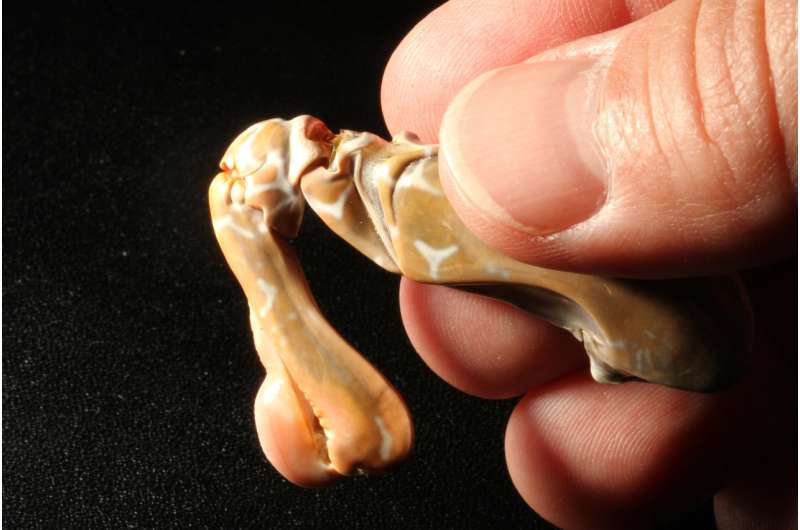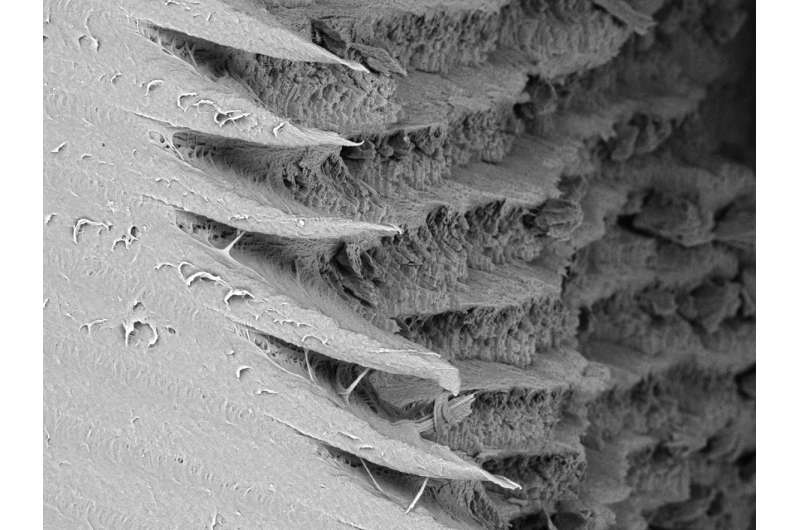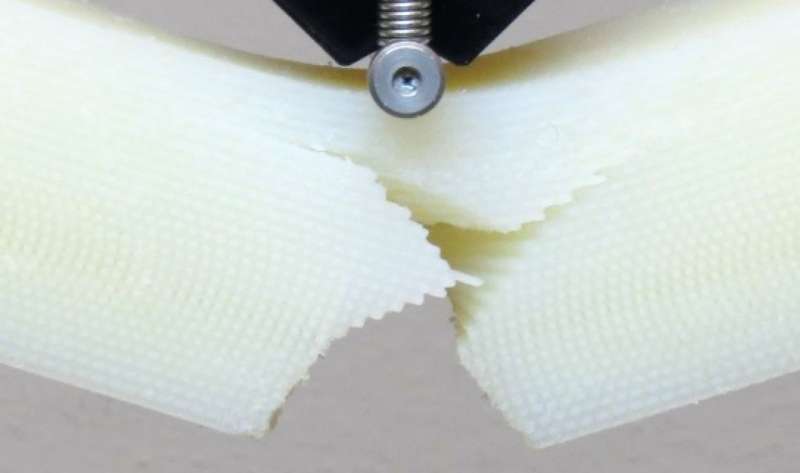Creature feature: Twisting cracks impart superhero toughness to animals

Super-resilient materials found in the animal kingdom owe their strength and toughness to a design strategy that causes cracks to follow the twisting pattern of fibers, preventing catastrophic failure.
Researchers in a recent series of papers have documented this behavior in precise detail and also are creating new composite materials modeled after the phenomenon. The work was performed by a team of researchers at Purdue University in collaboration with University of California, Riverside.
The researchers studied the preternatural strength of a composite material in a sea creature called the mantis shrimp, which uses an impact-resistant appendage to pummel its prey into submission.
"However, we are seeing this same sort of design strategy not just in the mantis shrimp, but also in many animals," said Pablo Zavattieri, a professor in Purdue's Lyles School of Civil Engineering. "Beetles use it in their shells, for example, and we also are seeing it in fish scales, lobsters and crabs."
What makes the mantis shrimp stand out is that it can actually smash and defeat its armored preys (mostly mollusks and other crabs), which are also known for their damage-tolerance and excellent mechanical properties. The mantis shrimp conquers them with its "dactyl club," an appendage that unleashes a barrage of ferocious impacts with the speed of a .22 caliber bullet.
New findings show that the composite material of the club actually becomes tougher as a crack tries to twist, in effect halting its progress. This crack twisting is guided by the material's fibers of chitin, the same substance found in many marine crustacean shells and insect exoskeletons, arranged in a helicoidal architecture that resembles a spiral staircase.
"This mechanism has never been studied in detail before," Zavattieri said. "What we are finding is that as a crack twists the driving force to grow the crack progressively decreases, promoting the formation of other similar mechanisms, which prevent the material from falling apart catastrophically. I think we can finally explain why the material is so tough."
Two papers were published in the Journal of the Mechanical Behavior of Biomedical Materials and the International Journal of Solids and Structures. The papers were co-authored by Purdue doctoral student Nobphadon Suksangpanya; UC Riverside doctoral student Nicholas A. Yaraghi; David Kisailus, a UC Riverside professor of chemical and environmental engineering and materials science and engineering; and Zavattieri.
"This exciting new analytical, computational and experimental work, which follows up on our initial biocomposite characterization of the helicoid within the mantis shrimp's club and biomimetic composite work, really provides a deeper insight to the mechanisms of toughening within this unique structure," Kisailus said.

"The novelty of this work is that, on the theory side, we developed a new model, and on the experimental side we used established materials to create composites that validate this theory," Zavattieri said.
Previous research has shown this helicoidal architecture is naturally designed to survive the repeated high-velocity blows, revealing that the fibers also are arranged in a herringbone pattern in the appendage's outer layer.
In the new research, the team has learned specifically why this pattern imparts such toughness: as cracks form, they follow the twisting pattern rather than spreading straight across the structure, causing it to fail. Images taken with an electron microscope at UC Riverside show that instead of a single crack continuing to propagate, numerous smaller cracks form – dissipating the energy absorbed by the material upon impact.
The researchers created and tested 3-D-printed composites modeled after the phenomenon, capturing the crack behavior with cameras and digital image correlation techniques to study the deformation of the material.

Byron Pipes, Purdue's John L. Bray Distinguished Professor of Engineering, helped Suksangpanya to fabricate glass fiber-reinforced composites incorporating this phenomenon.
"We are establishing new mechanisms that were not available to us before for composites,"
Zavattieri said. "Traditionally, when we produce composites we put fibers together in ways that are not optimal, and nature is teaching us how we should do it."
The findings are now helping the development of lighter, stronger and tougher materials for many applications including aerospace, automotive and sports.
More information: Nobphadon Suksangpanya et al. Crack twisting and toughening strategies in Bouligand architectures, International Journal of Solids and Structures (2018). DOI: 10.1016/j.ijsolstr.2018.06.004
Nobphadon Suksangpanya et al. Twisting cracks in Bouligand structures, Journal of the Mechanical Behavior of Biomedical Materials (2017). DOI: 10.1016/j.jmbbm.2017.06.010
Provided by Purdue University





















